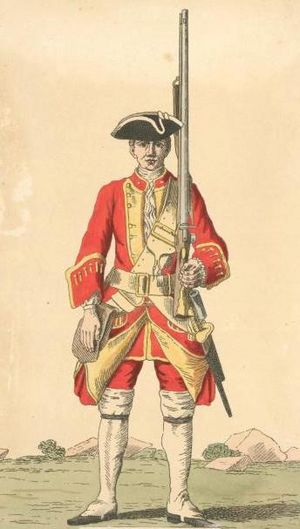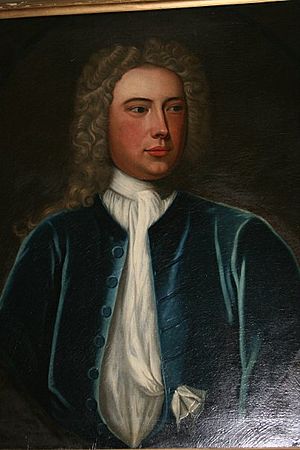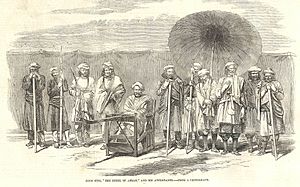37th (North Hampshire) Regiment of Foot facts for kids
Quick facts for kids 37th (North Hampshire) Regiment of Foot |
|
|---|---|
| Active | 1702–1881 |
| Country | |
| Branch | |
| Type | Infantry |
| Size | 1 battalion (2 battalions 1756–1758, 1813–1817) |
| Garrison/HQ | Lower Barracks, Winchester |
| Engagements | War of the Spanish Succession War of the Austrian Succession American Revolutionary War French Revolutionary Wars Napoleonic Wars Matale rebellion Indian Rebellion |
The 37th (North Hampshire) Regiment of Foot was a special group of soldiers, like a team, in the British Army. They were formed in Ireland in February 1702. This regiment was a type of line infantry, which means they fought in long lines on the battlefield. In 1881, the 37th Regiment joined with another group, the 67th (South Hampshire) Regiment of Foot. Together, they became the Hampshire Regiment, which was later renamed the Royal Hampshire Regiment.
Contents
Adventures of the 37th Regiment
How the Regiment Started
The 37th Regiment began in Ireland in February 1702. It was first known as "Meredyth's Regiment" after its leader, Lieutenant-General Thomas Meredyth.
In May 1703, the soldiers traveled to the Netherlands. They fought in some big battles with the famous leader, the Duke of Marlborough. These battles included the Battle of Schellenberg (July 1704), the Battle of Blenheim (August 1704), and the Battle of Ramillies (May 1706). They also fought at the Battle of Oudenarde (July 1708) and the Battle of Malplaquet (September 1709). These fights were all part of a big conflict called the War of the Spanish Succession.
In 1711, the regiment sailed to Canada for the Quebec Expedition. But their ships crashed on rocks in the Saint Lawrence River. Sadly, 8 officers and 253 men were lost. The expedition had to go home. Later, in October 1719, they were part of the Capture of Vigo in Spain.
Fighting in Europe
The regiment saw action again in June 1743 at the Battle of Dettingen. This was during the War of the Austrian Succession. They also fought in January 1746 at the Battle of Falkirk during the Jacobite rebellion. Their colonel, Sir Robert Munro, 6th Baronet, was killed there.
After that, they fought under Colonel Lewis Dejean at the Battle of Culloden in April 1746. In 1747, the regiment was officially given the number 37th Foot. They returned to the Netherlands and fought at the Battle of Lauffeld in July 1747.
On July 1, 1751, a new rule was made. Regiments would no longer be named after their colonels. Instead, they would get a number based on their history. So, the regiment became the 37th Regiment of Foot. In 1758, their second group of soldiers became a new regiment, the 75th Regiment of Foot.
The Seven Years' War and America
The regiment fought in the Seven Years' War at the Battle of Minden in August 1759. After winning this battle, the soldiers picked wild dog-roses and put them in their hats to celebrate! They also had smaller fights at Grebenstein in June 1762 and Fellinghausen in July 1762. From 1763 to 1769, they were stationed in Menorca, an island.
In 1776, the regiment sailed to North America to fight in the American Revolutionary War. They were at the Battle of Long Island in August 1776. They were also present when the British surrendered at the end of the Siege of Yorktown in September 1781. In 1782, their name changed again to the 37th (the North Hampshire) Regiment of Foot.
Napoleonic Wars and Beyond
The regiment was next in action at the Battle of Tournay in May 1794. This was part of the French Revolutionary Wars in the Low Countries. They were sent to the West Indies from 1800 to 1809, then to Gibraltar from 1812 to 1814, and finally to Canada from 1814 to 1826.
The Victorian Era and Final Years
In 1846, the regiment traveled to Ceylon. There, they helped stop the Matale rebellion in 1847. They moved to India in 1857. They fought against rebels at the Siege of Arrah in July 1857 during the Indian Rebellion.
The regiment returned to England in 1861 and then went to Ireland in 1865. In 1866, they were back in India. In the 1870s, new army changes called the Cardwell Reforms linked regiments together. The 37th Regiment was linked with the 67th (South Hampshire) Regiment of Foot. They shared a training base in Winchester.
The regiment returned to England in 1875 and moved to Ireland in 1880. On July 1, 1881, more changes happened with the Childers Reforms. The 37th Regiment officially joined with the 67th Regiment. They became the Hampshire Regiment, which later became the Royal Hampshire Regiment.
Important Victories
The 37th Regiment earned special honors for their bravery in battle. These are called "Battle Honours":




